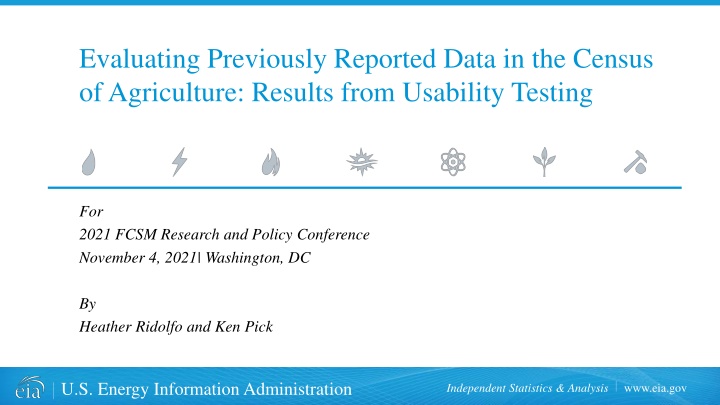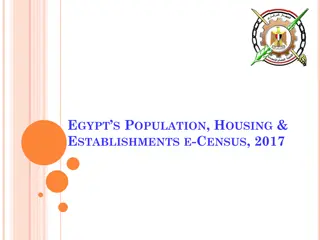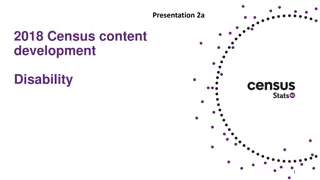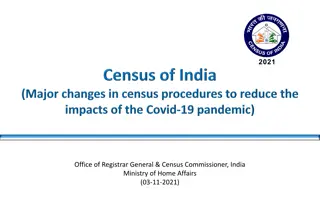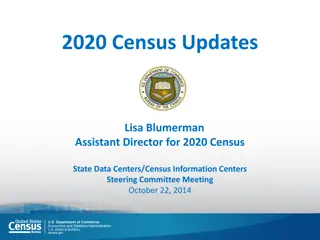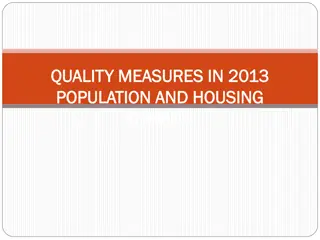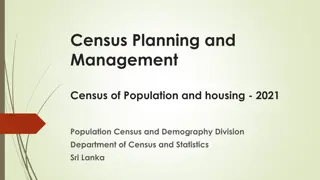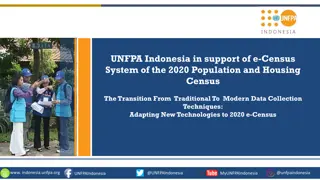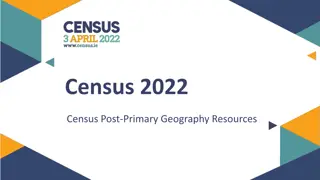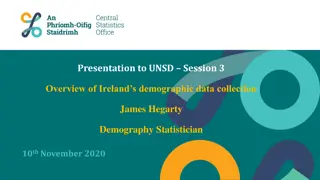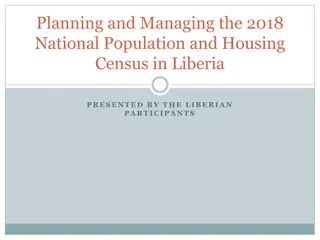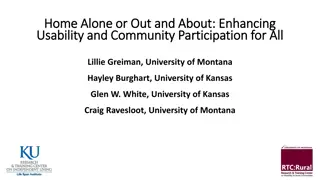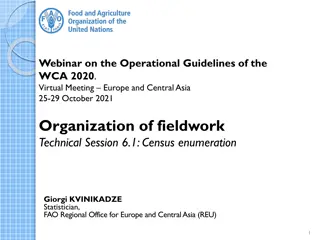Usability Testing of Previously Reported Data in the Census of Agriculture
Evaluation of the usability of previously reported data (PRD) in the Census of Agriculture through methodology involving remote interviews and survey responses. Research questions focus on the assistance to respondents, impact on efficiency, and measurement error/data quality. Findings from usability testing shed light on the potential benefits and challenges of utilizing PRD in survey questionnaires.
Download Presentation

Please find below an Image/Link to download the presentation.
The content on the website is provided AS IS for your information and personal use only. It may not be sold, licensed, or shared on other websites without obtaining consent from the author.If you encounter any issues during the download, it is possible that the publisher has removed the file from their server.
You are allowed to download the files provided on this website for personal or commercial use, subject to the condition that they are used lawfully. All files are the property of their respective owners.
The content on the website is provided AS IS for your information and personal use only. It may not be sold, licensed, or shared on other websites without obtaining consent from the author.
E N D
Presentation Transcript
Evaluating Previously Reported Data in the Census of Agriculture: Results from Usability Testing For 2021 FCSM Research and Policy Conference November 4, 2021| Washington, DC By Heather Ridolfo and Ken Pick U.S. Energy Information Administration www.eia.gov Independent Statistics & Analysis
Disclaimer All research presented today was conducted at the National Agricultural Statistics Service (NASS) The findings and conclusions in this presentation are those of the authors and should not be construed to represent any official USDA or U.S. Government determination or policy Heather Ridolfo, 2021 FCSM Research and Policy Conference November 4, 2021 2
Background Establishment respondents are surveyed frequently, sometimes multiple times per year Responding can feel burdensome and redundant Use of previously reported data (PRD) may ease that burden PRD in the 2022 Census of Agriculture Content Test web questionnaire Experiment Usability testing Heather Ridolfo, 2021 FCSM Research and Policy Conference November 4, 2021 3
Research Questions Does displaying PRD assist respondents? Does displaying PRD impact efficiency? Does displaying PRD impact measurement error/data quality? Heather Ridolfo, 2021 FCSM Research and Policy Conference November 4, 2021 4
Methodology Nine usability interviews in April May 2020 Conducted remotely using WebEx and Zoom Respondents used their own devices/browsers to view survey PRD presented as prefilled answers Usability Testing focused on PRD messaging and PRD use in 5 sections Heather Ridolfo, 2021 FCSM Research and Policy Conference November 4, 2021 5
PRD Messaging Heather Ridolfo, 2021 FCSM Research and Policy Conference November 4, 2021 6
First PRD Statement Heather Ridolfo, 2021 FCSM Research and Policy Conference November 4, 2021 7
Research Questions Heather Ridolfo, 2021 FCSM Research and Policy Conference November 4, 2021 8
PRD Statements Recommendation and Outcome Recommendation: Keep a statement on a separate screen at the beginning of the survey alerting respondents of the use of PRD and setting respondents expectations on how the PRD will be displayed and how they can use it Outcome: Revised first PRD statement instructing respondents to correct information that is no longer accurate Second PRD statement only appears on first screen with PRD Heather Ridolfo, 2021 FCSM Research and Policy Conference November 4, 2021 9
Reactions to and Utility of PRD Heather Ridolfo, 2021 FCSM Research and Policy Conference November 4, 2021 10
Positive Aspects of PRD Respondents generally like the idea of PRD When no change, PRD appears to reduce reporting burden (retrieval and judgement steps in response model) When no change, PRD appears to improve efficiency (comprehension and communication steps in response model) Anything that saves me time is good. Heather Ridolfo, 2021 FCSM Research and Policy Conference November 4, 2021 11
Example of Where PRD Worked Well Heather Ridolfo, 2021 FCSM Research and Policy Conference November 4, 2021 12
Negative Aspects of PRD When change occurred, PRD appeared to increase response burden and respondents questioned its source Changed occurred for different reasons: Information has changed Different respondent reported in the past Respondent entered information incorrectly in past (comprehension issue, typing issues, etc.) Errors in reading PRD into web instrument Use of PRD reduced the reading of questions and instructions (may reduce data quality) If answered incorrectly in the past, errors will not be corrected May not capture change Current presentation of PRD did not align with respondents expectations Web functionality worked against PRD Heather Ridolfo, 2021 FCSM Research and Policy Conference November 4, 2021 13
Where PRD Did Not Work Well: Example 1 Heather Ridolfo, 2021 FCSM Research and Policy Conference November 4, 2021 14
Where PRD Did Not Work Well: Example 2 Heather Ridolfo, 2021 FCSM Research and Policy Conference November 4, 2021 15
Where PRD Did Not Work Well: Example 2 I ve probably answered this with one all along my daughters would be insulted. Heather Ridolfo, 2021 FCSM Research and Policy Conference November 4, 2021 16
Where PRD Did Not Work Well: Example 2 Screen 1 Screen 2 Heather Ridolfo, 2021 FCSM Research and Policy Conference November 4, 2021 17
Where PRD Did Not Work Well: Example 2 Heather Ridolfo, 2021 FCSM Research and Policy Conference November 4, 2021 18
Summary Respondents had positive reaction to PRD when there was no change Some items can be easily answered without PRD Respondents did not always read full questions and instructions when PRD present When current answer is different from PRD, burden is increased and data quality may be affected Heather Ridolfo, 2021 FCSM Research and Policy Conference November 4, 2021 19
PRD Recommendations Recommendations: Conduct analysis to understand the variability of data from year to year, or census to census, before deciding on where to use PRD When using PRD, use it for all questions in a section, if appropriate Conduct additional review of dependent interviewing literature on how to present PRD in web form Align web functionality with PRD functionality Outcome: PRD removed from the personal characteristics section November 4, 2021 Heather Ridolfo, 2021 FCSM Research and Policy Conference 20
Thank you! Heather Ridolfo Heather.Ridolfo@eia.gov Ken Pick Kenneth.Pick@eia.gov Heather Ridolfo, 2021 FCSM Research and Policy Conference November 4, 2021 21
